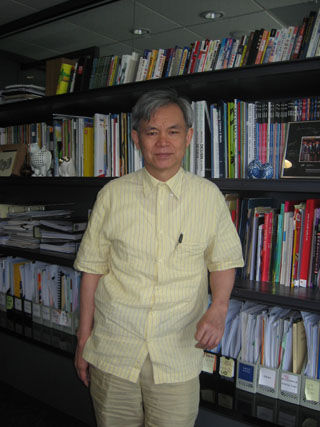"Taiwan's Design Industry is Drawing Increasing Attention From the World"
2008/07/17 | By Quincy LiangTony Chang, CEO of the national Taiwan Design Center (TDC), has a clear vision of how the island can play a more important role on the world's design stage. In fact Taiwan is already No. 2 in Asia in this field, after only Japan.

The TDC serves as an integrated platform that offers a comprehensive range of services to the creative design industry. At home, it combines the efforts of academia, the government, and industry in the development and promotion of design strategies, technological research, industrial support, and knowledge management; internationally, it hopes to act as a platform for the integration of global design resources.
In addition to heading up the TDC since its establishment in 2004, Chang has long been active in the global design industry. He was, for instance, the first Taiwanese board member (in 2005-2007) of the International Council of Societies of Industrial Design (ICSID), a design promotion organization that represents an estimated 150,000 designers in more than 50 countries, and jury member for two of the world's major design awards, reddot (2007-2008) and iF (2007).
Chang believes that 2008 will be a watershed year for the local design industry, because by midyear it had garnered over 160 awards, including grand prizes, in major international design competitions such as iF and reddot. Taiwan also won the Industrial Design Excellence Award this year.
"When you add the 20-30 awards that Taiwan is expected to win at the upcoming G-Mark awards in Japan, the results of which will be announced in early October," the CEO predicts, "Taiwan is very likely to win over 200 awards in the top-four international design competitions for the first time this year."



Chang points out, however, that Taiwan will have to overcome some tough challenges before it can become a real world-class player on the global design stage.
Chang points out that the design industry can be divided into three sectors: design services, designer brands, and a combination of design, brand, and sales channels.
In the global design service industry, Chang observes, there is a trend away from specialization and toward broader and more versatile operations; instead of concentration on just one field a design firm might, for instance, encompass such diverse fields such as industrial and graphic design.
Taiwan is just beginning to catch on to this trend, and even the biggest design studios on the island, such as Nova Design, are only in the initial state of cross-field operations. Chang hopes to accelerate the trend. "Cross-field design companies are total design solution providers," he notes, "and they are often more strongly competitive and profitable than narrowly focused designers. The TDC has been working vigorously to help local design companies evolve into total solution providers and become world-class players."
In the designer brand sector, Chang reports, more and more big companies are building up their power to influence global design trends and build up their own brands. Examples of this are provided by Philippe Starck of France and Toshiyuki Kita of Japan's Issey Miyake.



Taiwan is relatively weak in this area, the CEO concedes, and it is necessary for the island to cultivate globally prominent designers who can boost the momentum of the local design industry and bring the attention of the world to the island's design line.
In the combination of design, brand, and sales channels, ALLESI of Italy provides a good example. "ALLESI is a successful platform that encompasses around 6,000 sales points worldwide as well as an integrated design platform, allowing its designers to exert their talents for customers in different countries," Chang explains. "Over the past few years the TDC has succeeded in negotiating a partnership between ALLESI and the local National Palace Museum, which has exposed the museum to the world and made its commercialized products a big market success."
How to Get There
Given Taiwan's limited market, Chang emphasizes, the domestic design industry has to go international.
First, he says, it has to recruit and cultivate the best marketing personnel so that they can boost the local design service industry onto the international stage. To that end, the TDC is actively seeking cooperation with both local and foreign marketing experts and organizations.
Second, it has to increase the exposure of Taiwan's design talent and capability at major international trade fairs; at the 2008 Taipei International Information Technology Show (Computex Taipei) in June, for example, six local design studios mounted exhibits and reported successful sales results.
Third, the industry has to strengthen the international competitiveness of local design companies, especially in the promotion of their services. Domestic design firms lack experience in this area, Chang believes, and so are prone to miss out on business opportunities despite having excellent ideas. To overcome this deficiency, the TDC has been inviting major companies in the field to share their knowledge with local firms.
Fourth, Chang says, the industry has to collect the most advanced, real-time information on market surveys, trendy color schemes, the latest materials, and the like so as to upgrade its competitiveness. To help achieve that upgrading, the TDC is cooperating with other organizations, such as the Color Marketing Group (CMG), a top international association of color design professionals, for the provision of related information to local companies.
Fifth and last, according to Chang, the industry must encourage the formation of strategic alliances between local and foreign design companies. "Most design firms in Taiwan are relatively small and lack a comprehensive range of capabilities," he explains. "Through strategic alliances with foreign partners, they can acquire the resources they need in marketing, design capability in unfamiliar fields, consulting, etc."
IDA Congress Coming in 2011
"Taiwan's design industry has been drawing rapidly increasing attention from the whole world," Chang claims, "thanks to the joint efforts of local designers, the government, and related organizations. Now, the biggest news ever for the industry is that Taipei outbid 18 other cities in 18 countries to win the right to host the 2011 IDA Congress; this meeting, held every six years, is the world's most important design event."
This success is proof of Taiwan's increasing influence in the global design industry, Chang says, and of the government's strong support for its development.
The congress, Chang predicts, "will attract over 2,000 international heavyweight designers and experts. Through the experience of preparing for and holding the event, I think that Taiwan's design industry and the TDC, which is the main organizer, will gain valuable expertise and another dose of momentum for growth."




